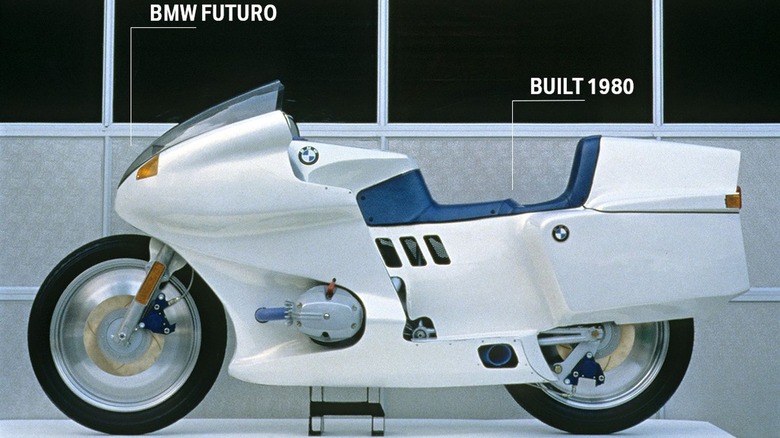The BMW Futuro Was A Futuristic, Yet Bizarre '80s Concept Motorcycle
Believe it or not, BMW has been making motorcycles for almost 100 years now. It showed off its first two-wheeled R32 motorcycle at the Berlin Motor Show in 1923, and the German motor company has been going strong ever since. In fact, its Motorrad division had its best year in 2021 — selling more than 194,200 units.
BMW has not been one to shy away from challenges, evolving its brand, or pushing the latest technology into its motorcycles. Such is the case with the Futuro concept bike unveiled at the Cologne Show in September 1980. That just so happened to be the very same show where some legendary motorcycles made their first appearances, including Honda's CX Turbo, the Suzuki Katana, and Yamaha's first V-twin engines. Even the most die-hard of enthusiasts might have a hard time remembering the Futuro amidst those titans of the motorcycle industry.
Still, despite being mostly forgotten in the annals of motorcycle history, the Futuro was loaded with several first-of-its-kind features, and is actually considered by some to be the first proper "modern concept bike." BMW's push into motorcycle prototypes was developed in conjunction with car customizer Buchmann (B&B), along with a number of research firms and parts suppliers.
The Futuro was ready for the future
BWM was trying to show the world that its tried and true four-stroke, 785cc two-cylinder "Boxer" engine was still worthy by giving it a turbo add-on. This was a move that preceded the industry's bandwagon jump to the turbo craze (via Visor Down), so it was a prescient decision. The Futuro had a top speed of 125 mph, but the most notable thing about the bike was its overall look and design.
The entirety of the bike was enclosed with a one-piece, aerodynamic fairing made of Kevlar carbon fiber — the first one of its kind. It was light enough to lift with one hand, yet firm and rigid enough to protect the bike and rider. By using Kevlar, the motorcycle only weighed 397 pounds in total. By comparison, the "average" weight of a bike is around 700 pounds, which is entirely dependent on the exact make and model.
Other unique features included complete disc wheels, a wraparound cowling, integrated rearview mirrors, and a rear trunk, which is said to have inspired Honda's Pacific Coast motorcycle (via Moto-Collection). It also had a monocoque frame and parallelogram rear suspension that wouldn't become a standard component on BMW bikes until 1987.
The final dash of "future" was the advanced computer-aided electronic information system, referred to as the "bi-directional multiplex system." It not only kept the rider updated on standard bike functions (fuel, temp, speed, etc.) but also fed "the latest traffic news" to them.
The Futuro made only one appearance, but it made a big enough splash that some of its technological features left a lasting legacy on the industry.
